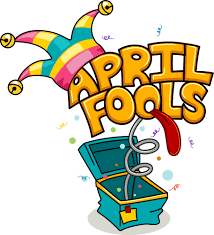Do things that would be viewing eyes for a Kindergartner Safe
- Katherine Victoria Vananderland
- Aug 27, 2020
- 3 min read

April Fools Day April 1st 2021
Lesson Plan #135
Teacher: Miss Katherine Victoria VanAnderland, Original Copy
Date: 08/17/20
Overview & Purpose
The biggest prank day of the year started way back years ago and it still happens sometimes if people remember to do it. Amidst being celebrated for centuries in many parts of the world, the origin of April Fools’ Day is still uncertain. The most popular theory about the origin of April Fools’ Day involves the French calendar reform of the sixteenth century. In 1564, France reformed its calendar, moving the start of the year from the end of March to January.
Education Standards
Reading Skills
Comprehension skills
Logic and Philosophy
Objectives
Learn about the holiday and when it started
Read all materials
Pick your favorite worksheet and work on that one
Materials Needed
Verification
Steps to check for student understanding
Complete all Worksheets
Write about the funnest prank you have pulled and if it worked
Write a top ten list of all time pranks and jokes
Activity
Describe activity that will reinforce the lesson
History behind the April Fools Day:
Key Facts & Information
BACKGROUND AND UNCERTAIN ORIGIN
Amidst being celebrated for centuries in many parts of the world, the origin of April Fools’ Day is still uncertain. The most popular theory about the origin of April Fools’ Day involves the French calendar reform of the sixteenth century. In 1564, France reformed its calendar, moving the start of the year from the end of March to January 1. The people who failed to keep up with the change, who stubbornly clung to the old calendar system and continued to celebrate the New Year during the week that fell between March 25th and April 1st, had jokes played on them.
Some believed that it marks the change in season specifically the first day of spring in Northern Hemisphere or vernal equinox.
It was Pope Gregory XIII who changed the Julian Calendar to the Gregorian calendar in 1582 which resulted in the confusion of people in France and eventually in most parts of Europe.
However, the Gregorian calendar was not adopted in England until 1752, which made the theory of April Fools’ Day origin vague.
Another link was ancient Hindu’s and Roman’s celebration of New Year’s Day around April 1. Every March 25, ancient Romans celebrated the festival of Hilaria which is the time to rejoice the resurrection of Attis.
Meanwhile, ancient Hindus have Holi to celebrated the transition of seasons from winter to spring.
Joseph Boskin, a professor of History in Boston University provided another explanation which involved the reign of Constantine as emperor of the Holy Roman Empire. According to Boskin, April Fools’ Day had its base in a group of jesters, led by a man named Kugel who proposed to the emperor that he could rule the kingdom better.
APRIL FOOLS’ TRADITIONS
The earliest recorded association between April 1, pranks, and foolishness can be found in Chaucer’s Canterbury Tales which was written in 1392.
Pranksters would secretly stick paper fish to people’s backs. The victims of this prank were called Poisson d’Avril, or April Fish, which, to this day, remains the French term for April Fools.
In Scotland, this day is traditionally called as Huntigowk Day. A sealed message that reads “Dinna laugh, dinna smile. Hunt the gowk another mile” would be sent. Upon reading it, the recipient will send it to another person for him/her to help the sender.
In the Nordic countries of Norway, Iceland, Finland, and Sweden, news media outlets publish one fake story on April 1.
In the United States, the pranks last all day, but in other countries they only take place until noon.
A Joker, a Court Jester, and a Jokester have become the images associated with April Fool’s Day.
Some people spend a lot of money and time planning elaborate jokes.
Spain, Hispanic America, and the Philippines celebrate the Day of the Holy Innocents on December 28, which is similar to April Fools’ Day.
In Belgium, some call it the Day of Innocent Children or Day of Stupid Children.
Countries in Western Europe, including Italy, France, and Belgium celebrate this day with April Fish. This tradition involves children drawing and cutting out a picture of a fish.
April Fools’ Day is not an official holiday. However, it is popularly celebrated in many countries such as France, Greece, India, Brazil, Ireland, Italy, Poland, Scotland, Sweden, United Kingdom, and United States.









Comments